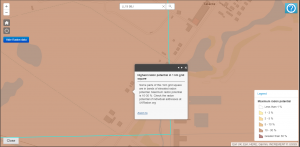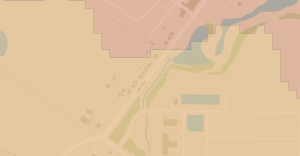
Radon: Handling the Hotspots
Radon is invisible, odourless and causes more than 1,100 deaths from lung cancer each year* in the UK. It is responsible for more premature deaths than drink-driving and workplace accidents combined. There are specific hotspots where it is directly related to the geology beneath and which must be considered by clients in property transactions and any future renovations.
Radon is a naturally occurring radioactive gas released through the decay of uranium, which is present to some degree in all soils and rock. However, certain types of rock, such as granite are more prone to releasing the gas through cracks and faults and accounts for particularly higher levels affecting properties in the South West and North West of England and North Wales.
A client may be very taken with a picture postcard stone cottage with a recent extension on the edge of Bodmin Moor in Cornwall, for example. Looking around the property, it would have been impossible to see, hear, smell or taste the gas as it circulated around the rooms.
Warm air inside the house draws the gas in through gaps in suspended floors and any gaps or cracks in a building’s structure – for example around service pipes.

Radon hotspot areas – courtesy of UKRadon
But radon is a national phenomenon with hotspots distributed across the country. In June of this year, 600 households in the Liverpool City Region were sent letters advising that they were to receive radon testing kits from PHE.
Underground, radon can collect in caves and mines, many of which litter the subterranean landscapes of Devon and Cornwall from past shallow excavations for tin and other minerals.
As such, basements are one of the confined spaces in a property that tend to be subject to high concentrations of radon.
Someone who has grown up in one of these hotspots and wants to stay in the same area may not be aware of radon as a risk. It is not something that has often historically been considered when looking for a property.
So, one of the first and most important enquiries on any property search in a Radon hotspot area is how high are the likely exposure levels and does the property have any form of protection against the risk?
What is the radon action level?
PHE has used available data to produce a set of maps indicating the areas of the country where it is estimated that the greatest number of properties will be affected by radon.
The measurement for Radon is becquerels per cubic metre of air (Bq m-3). The average reading for radon levels in most of the homes is around 20 Bq m-3.
PHE has set the UK Action Level for radon at 200 Bq m-3. Anything above this needs further action to reduce radon levels in the property.
The national risk measurement is divided as follows:
- Less than 1% of properties are above the action level (low risk –level 1)
- Between 1 and 10% of properties are above the action level (medium risk –level 2)
- More than 10% of properties are above the action level (higher risk –level 3)
How serious is Radon to your Health?
- Radon increases the chance of having lung cancer
- In the UK 1100 deaths from lung cancer each year are estimated to be caused by exposure to radon*
- The longer the exposure to radon, the greater the risk
Health impacts can be seen at levels below the action level according to PHE. However the risk is considerably less if you do not smoke. We know that smoking is the biggest cause of lung cancer but there is a combined risk where a smoker lives in a house with high radon levels.
Measuring and testing for Radon
Although invisible, radon levels are easily measurable and can be reduced by undertaking testing and making modifications to your client’s property. However, this is not a quick process and if the property does not have any existing modifications and is in a higher risk area, testing and remediation can take a number of months and could significantly slow down the transaction.
Radon levels can vary significantly over time due to weather conditions and seasonal changes, so testing should run ideally over a minimum 3 month period. The test kits are usually placed in the main living areas of your home and then sent for laboratory analysis to obtain a yearly average for the Becquerel level.
What can be done to reduce Radon levels?
There are three main solutions that can be applied to a building either independently or in tandem, to reduce indoor radon levels which simply put, seek to prevent the build-up of radon gas in the home.
- Sump system – Effective for all radon levels
- Improved under floor ventilation – generally effective for radon levels up to 500 Bq m-3
- Mechanical ventilation – effective for all radon levels.
These can be supplemented with improved house ventilation and simple sealing of floors and walls which can reduce levels by as much as 50% on their own.
If the property has a solid concrete ground floor, radon laden air can be extracted from beneath the floor (de-pressurising the soil) by using a radon sump. This is generally the most effective method, and in many cases will reduce the radon level to less than one-tenth of the original level. For radon levels above 1200 Bq m-3 it is often the only solution.
In addition to the sump, a positive pressure system installed can also have the benefit of providing your property with fresh and filtered air whilst diluting the radon contaminated air.
What is the Radon Target Level?
The Target Level of 100 Bq m-3 is the recommended level set by PHE for remediation works in existing buildings and protective measures in new buildings. If the result of a radon assessment is between the Target and Action Levels, action to reduce the level should be seriously considered, especially if there is a smoker or ex-smoker in the home.
Radon protection and Planning
Since the 1990’s all new build properties have had radon precautions installed. This could be a radon barrier (well-sealed plastic membrane) and depending upon its construction type, a mini sump or air bricks. If the barrier fails then the sump if fitted can be activated by attaching an electric fan.
When extensions are made to existing buildings in high radon areas, or new buildings are constructed in these areas, the Building Regulations require that protective measures are taken against radon entering the building.
Depending on the probability of buildings having high radon levels, the Regulations require:
- No protective measures where the risk level is low
- Basic protective measures where the risk level is intermediate
- Full protective measures where the risk level is high
It would be easy to assume that older properties cannot easily be retro-fitted with radon protection measures. But this is not the case: They can be remedied without adversely affecting the structure if the building, their aesthetics or potential resale value. There is no restriction if the property is in a conservation area or has listed status.
Interpreting results and making enquiries
Radon is no different than other minor building problems such as rising damp or timber rot which is routinely dealt with at the time of house purchase. It should not be seen as a reason for not buying a particular house but important enquiries are needed to check if the property has been tested, where it sits within the three risk levels we explained above and whether any protective measures are already in place.
If the property is in an area at risk level 1 – the client shouldn’t need to take any action. However, for locations at risk level 2 or 3 where no protective measures already exist, they might choose to continue with the purchase but consider renegotiating the price with the seller or agreeing a bond to cover remedial costs should they prove necessary. They could then test the house once they have moved in. This is especially important for clients that are smokers or ex-smokers.
Is your client affected?
So, understanding if your client needs to be prepared to consider the impact of radon on their purchase, including any adaptations to the property, is an important first step ahead within the property searches.
PHE has a website that allows you to search for whether the postcode is affected by Radon. However, the data is an indicative map based on the results of actual tests but is held at low resolution 1km grids. Environmental risk report data, such as that provided by Future Climate Info, includes the Radon Potential Dataset from the British Geological Survey (BGS), with a much higher resolution of 25m (based on data buffered to 75m) and is therefore based on the nature of the underlying geology and its potential for radon generation.


The above two images are of the Station Road area in Talacre, Flintshire in North Wales. The left hand image shows the data from the Radon Indicative Atlas, which is free from UKradon, is less granular and suggests a blanket level of higher risk (10-30% of properties affected by radon). Whereas to the right, the Radon Potential Dataset clearly shows how specific properties in the medium risk (1-10% of properties affected) which could have a different negotiating stance in the transaction.
This provides a more accurate representation of the potential risk of exposure to radon, accounting for local hotspots which can make all the difference in terms of further testing and negotiation.
For more information on Future Climate Info’s environmental risk reports and radon data, contact us on 01732 755180 or email us at info@futureclimateinfo.com
References:
*1100 deaths per year figure comes from University of Oxford research funded by Cancer Research UK, the Medical Research Council, the European Commission sixth framework programme, and the National Institute for Health Research. The study was published in the peer-reviewed British Medical Journal. https://www.bmj.com/content/338/bmj.a3110
UKRadon
https://www.ukradon.org/information/radonsearches
https://www.ukradon.org/information/ukmaps
https://www.ukradon.org/information/level
Building Research Establishment
UK Radon Association
http://www.radonassociation.co.uk/guide-to-radon/information-for-house-buyers-and-sellers/
Try before you buy
To take advantage of a trial free order of your first environmental report, please complete the enquiry form and we will get back to you as soon as possible. We will need to take more details of the property or site and ask some more questions about your firm and the transaction.

